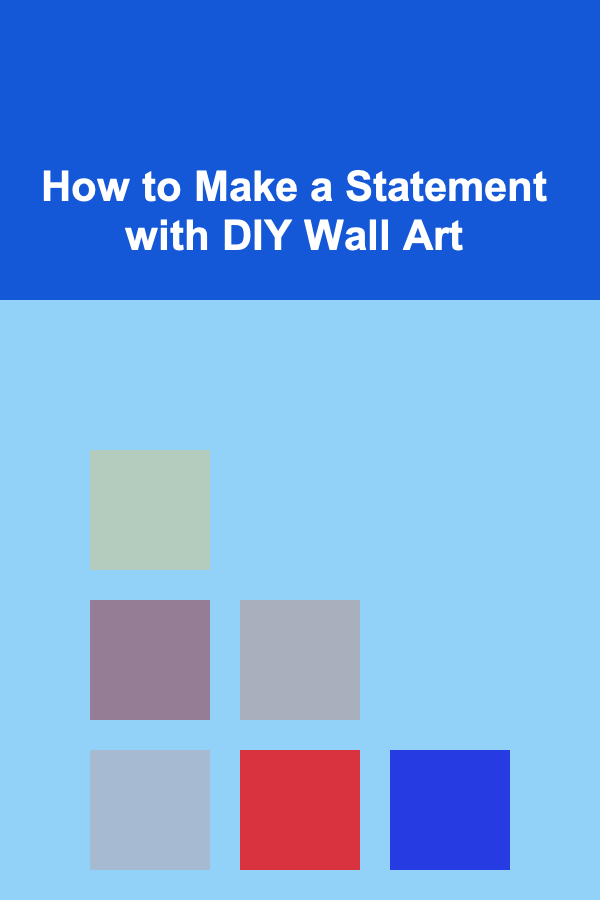
How to Make a Statement with DIY Wall Art
ebook include PDF & Audio bundle (Micro Guide)
$12.99$9.99
Limited Time Offer! Order within the next:

Creating a striking atmosphere in your home doesn't have to come at a high cost. One of the most impactful ways to personalize your space is through art, and making your own DIY wall art can elevate your decor while showcasing your creativity. From bold colors and textures to intricate designs and mixed media, there's a plethora of options available for anyone looking to make a statement. This guide will delve into various techniques, materials, and inspirations for creating DIY wall art that resonates with your personal style and transforms your living environment.
Understanding the Power of Wall Art
1. Setting the Mood
Wall art plays a crucial role in establishing the mood of a room. It can evoke emotions, influence ambiance, and even inspire creativity. The right piece can turn a sterile space into a warm and inviting one.
2. Personal Expression
Art is an extension of the self, allowing individuals to express their personalities, beliefs, and experiences. Creating your own wall art provides a unique opportunity to reflect on what matters most to you.
3. Focal Points
Large pieces of art can serve as focal points in any room, drawing the eye and anchoring the overall design. They can create drama and interest, helping to define the space.
4. Cost-Effective Decor
Purchasing original artworks from galleries or artisans can be expensive. DIY wall art offers an affordable alternative that allows for customization without sacrificing quality or uniqueness.
Getting Started: Planning Your DIY Wall Art
Before diving into the creation process, it's essential to plan your project:
1. Define Your Style
Consider the aesthetic of your home and what styles resonate with you. Some popular styles include:
- Modern: Clean lines, geometric shapes, and minimalist designs.
- Abstract: Bold colors, shapes, and forms that evoke emotion without being representational.
- Bohemian: Eclectic mixes of patterns, vibrant colors, and natural elements.
- Rustic: Incorporating natural materials, earthy tones, and vintage elements.
2. Choose Your Space
Decide where you want to display your DIY wall art. Each space has its unique characteristics:
- Living Room: Ideal for large statement pieces that invite conversation.
- Bedroom: Soft and calming designs that promote relaxation.
- Office: Motivational or inspiring artwork that enhances focus.
3. Gather Inspiration
Collect images and ideas that inspire you. Platforms like Pinterest, Instagram, and design blogs can provide abundant resources. Create a mood board to visualize how different pieces and styles can come together.
4. Determine Size and Scale
The size of your artwork should correspond to the space where it will be displayed. Larger pieces tend to work better in expansive areas, while smaller works can complement existing decor.
Materials and Tools for DIY Wall Art
Choosing the right materials is crucial for the success of your project. Here are some common supplies you may need:
1. Canvas and Wood Panels
- Canvas: Available in various sizes and shapes, canvas is a versatile option. Pre-stretched canvases are easy to work with and ready for painting.
- Wood Panels: For a more rustic look, consider using wood panels. These can be painted, stained, or left natural.
2. Paints
- Acrylic Paints: Fast-drying and versatile, acrylic paints are perfect for beginners. They can be used on various surfaces and are available in numerous colors.
- Watercolors: If you prefer softer, translucent effects, watercolor paints can create beautiful blends and gradients.
3. Brushes and Tools
- Brushes: A variety of brush shapes and sizes will help achieve different effects. Invest in both flat and round brushes for versatility.
- Sponges: Use sponges for creating texture and applying paint in a unique way.
- Palette Knives: Perfect for mixing colors and creating textured strokes.
4. Mixed Media Supplies
Consider incorporating various materials for added depth and dimension:
- Fabric and Textiles: Use old clothes or fabric scraps to add layers to your art.
- Paper and Cardstock: Cutouts can create interesting shapes and patterns.
- Natural Elements: Incorporate items like leaves, twigs, or flowers for a nature-inspired touch.
5. Adhesives and Finishing Supplies
- Glue: For adhering fabric or paper elements.
- Varnish or Sealant: Protect your finished artwork and enhance its longevity.
Techniques for Creating DIY Wall Art
With your materials gathered, it's time to explore various techniques for creating stunning wall art:
1. Painting Techniques
a. Abstract Painting
Abstract art allows for freedom of expression and creativity. You don't need to follow strict rules; instead, focus on color, shape, and texture.
- Pouring Technique: Mix acrylic paints with pouring medium to create fluid art. Pour onto canvas and tilt to spread. This technique produces mesmerizing patterns and effects.
- Color Blocking: Divide the canvas into sections and paint each block a different color. This modern approach adds visual interest and simplicity.
b. Landscapes and Nature Scenes
Capture the beauty of nature with landscape paintings. This can range from realistic depictions to impressionistic interpretations.
- Layering Colors: Use multiple layers of paint to build depth in skies or foliage. Blend colors gradually to achieve realistic transitions.
- Palette Knife Techniques: Use a palette knife to create texture in landforms, water, and clouds.
2. Collage Art
Collage art involves combining various images, textures, and materials to create a cohesive composition.
a. Paper Collage
- Magazine Cutouts: Gather images from magazines that resonate with your theme. Arrange them on your canvas before gluing them down.
- Layering: Experiment with layering different papers to create depth and intrigue.
b. Fabric Collage
- Textile Pieces: Cut fabric into shapes and arrange them on a canvas. Stitch or glue them down to add texture.
- Mixed Media Collage: Combine paper and fabric for a multi-layered effect.
3. Typography and Quotes
Incorporating words or quotes into your wall art can add a personal touch:
a. Hand Lettering
- Brush Pens: Use brush pens to create flowing letters that convey your message artistically.
- Stencils: If handwriting isn't your strength, consider using stencils for clean and uniform letters.
b. Vinyl Letters
- Cutting Machines: If you have access to a cutting machine like a Cricut, design and cut vinyl letters to adhere to your canvas.
4. Wall Sculptures
For a three-dimensional effect, consider creating wall sculptures that pop off the canvas.
a. Natural Elements
- Wooden Shapes: Use wooden blocks or dowels to create shapes that are attached to the canvas.
- Found Objects: Incorporate items like driftwood, stones, or shells for a beachy or rustic feel.
b. Clay and Modeling Material
Utilize air-dry clay or other modeling materials to create shapes or textures on a canvas.
- Sculptural Elements: Form characters, flowers, or abstract shapes to enhance your artwork.
Displaying Your DIY Wall Art
Once your artwork is complete, displaying it effectively is key to making a statement:
1. Create a Gallery Wall
A gallery wall allows you to showcase multiple pieces and creates visual interest.
- Mix Sizes and Styles: Combine various sizes and styles of frames for an eclectic look.
- Layout Planning: Arrange the pieces on the floor before hanging to find the best layout.
2. Choose the Right Location
Select a location that highlights your artwork. Consider the following tips:
- Height Matters: Hang art at eye level for maximum impact.
- Adjacent Spaces: Group artwork near furniture, such as sofas or consoles, to create a cohesive look.
3. Use Lighting
Proper lighting can dramatically enhance the appearance of your wall art.
- Spotlights: Install adjustable spotlights to direct light toward specific pieces.
- Ambient Lighting: Use soft lighting to create an inviting atmosphere around your artwork.
4. Rotate Artwork Seasonally
Changing your displays seasonally keeps things fresh and exciting.
- Seasonal Themes: Create seasonal artwork or swap out existing pieces to match the time of year.
- Interchangeable Frames: Use frames that allow for easy swapping to update your decor frequently.
Maintenance and Care for Your Artwork
To ensure your DIY wall art lasts, consider these maintenance tips:
1. Dust Regularly
Dust can accumulate over time, diminishing the vibrancy of your artwork. Use a soft cloth or feather duster to gently clean the surface.
2. Protect from Direct Sunlight
Direct sunlight can fade colors and damage materials. Position artwork away from harsh sunlight or use UV-protective glass if framing.
3. Repair Damage Promptly
If any part of your artwork gets damaged, address the issue as soon as possible to prevent further deterioration.
4. Store Properly
If you need to store your artwork, do so in a cool, dry space. Use acid-free materials for wrapping and avoid stacking heavy items on top.
Inspiring Ideas for DIY Wall Art
Here are some creative themes and concepts to spark your imagination as you embark on your DIY wall art journey:
1. Nature-Inspired Art
Create pieces that celebrate the natural world. Utilize organic materials like leaves, flowers, or branches in your designs.
2. Travel Memories
Transform photographs and mementos from travels into wall art. Create collages or framed prints that commemorate special moments or places.
3. Family Heritage
Showcase your family history by creating a family tree or displaying photos of ancestors. This adds a personal touch to your decor.
4. Inspirational Quotes
Select quotes that resonate with you and translate them into art. Use typography and artistic designs to create visually appealing pieces.
5. Color Themes
Choose a color palette that reflects your mood or desired ambiance. Create monochromatic pieces or contrasting color schemes for impact.
Conclusion
Creating DIY wall art is a rewarding endeavor that not only beautifies your space but also serves as a creative outlet. By planning thoughtfully, experimenting with various techniques, and expressing your personal style, you can craft stunning pieces that make a significant statement in your home.
Whether you opt for painting, collage, or sculpture, the possibilities are endless. Embrace the journey, allow your creativity to flourish, and enjoy the transformation of your walls into a vibrant reflection of who you are. Remember, the beauty of DIY art lies not just in the final product but in the joy and satisfaction of the creative process itself. So gather your materials, unleash your imagination, and let your walls tell your unique story.
Reading More From Our Other Websites
- [Home Budget 101] How to Budget for Utilities Without Going Over Your Limit
- [Home Soundproofing 101] How to Soundproof a Room for Better Recording Quality
- [Organization Tip 101] How to Store Fabric Scraps Creatively
- [Home Holiday Decoration 101] How to Create a Holiday Garden Display to Brighten Your Yard
- [Personal Finance Management 101] How to Invest Wisely for Beginners Without Taking Too Many Risks
- [Home Rental Property 101] How to Negotiate Lease Terms When Renting an Apartment with a Dishwasher: What to Look For
- [Organization Tip 101] How to Use Labels for Clear Home Inventory Organization
- [Home Cleaning 101] How to Deep Clean Curtains and Drapes for a Dust-Free Home
- [Horseback Riding Tip 101] Best Techniques for Balancing on a Semi‑Western Saddle During Trail Rides
- [Organization Tip 101] How to Create an Inclusive Environment in Volunteer Spaces

How to Build a Checklist for Complying with WCAG (Web Content Accessibility Guidelines)
Read More
How to Personalize Your SMS Messages for Better Abandoned Cart Recovery in Dropshipping
Read More
How to Store Away Extra Bedding and Linens Neatly
Read More
How to Use Lighting to Make Your Home Feel Like a Retreat
Read More
How To Overcome Workplace Politics (Psychological Approaches)
Read More
How to Make Healthy Salad Dressings for Weight Loss
Read MoreOther Products

How to Build a Checklist for Complying with WCAG (Web Content Accessibility Guidelines)
Read More
How to Personalize Your SMS Messages for Better Abandoned Cart Recovery in Dropshipping
Read More
How to Store Away Extra Bedding and Linens Neatly
Read More
How to Use Lighting to Make Your Home Feel Like a Retreat
Read More
How To Overcome Workplace Politics (Psychological Approaches)
Read More